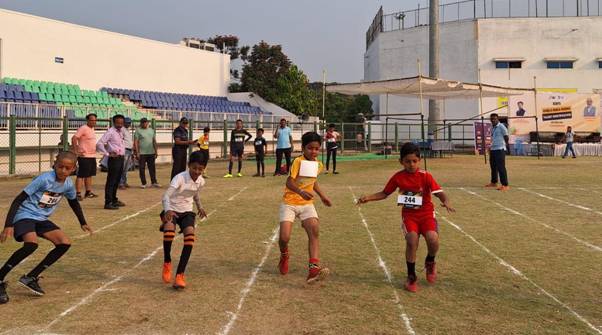For generations, sports in India were seen as a pastime squeezed between schoolwork and exams — a hobby on dusty fields rather than a career to aspire to. Limited infrastructure and a societal focus on academics meant few dared to dream of donning the national colours. But over the years, that narrative has steadily transformed, and today, with the launch of Khelo Bharat Niti 2025, India is set to redefine its sporting destiny.
Launched under the vision ‘From Grassroots to Glory’, the landmark policy is poised to reshape the country’s sports ecosystem. Integrating with the National Education Policy (NEP) 2020, Khelo Bharat Niti aims to bridge the gap between classrooms and playgrounds, recognizing sports as an essential component of holistic development. It prioritizes women’s empowerment, outreach to marginalized and tribal communities, and active engagement with the Indian diaspora.
A Vision for the 2036 Olympics
With its eyes set firmly on the global stage, India’s ambitious roadmap includes a strategic push to become a sporting powerhouse by the 2036 Olympics — and to stake its claim as a potential host. This vision is backed by substantial funding: for FY 2025–26, the Ministry of Youth Affairs and Sports has been allocated ₹3,794 crore, marking a 130.9% increase from FY 2014–15. Of this, ₹1,000 crore is earmarked for the flagship Khelo India programme alone.
Building the Sporting Ecosystem
The policy focuses on talent identification at the grassroots level, competitive leagues, world-class training, and sports science support. It calls for significant private sector participation through public-private partnerships, corporate social responsibility, and innovative funding models, laying the groundwork for a sustainable sports industry.
Sports are also being positioned as a major economic driver, with an emphasis on boosting sports tourism, hosting international events, and nurturing sports startups. The goal is to transform sports from a niche pursuit into a vibrant sector generating livelihoods and national pride.
A Network of Opportunity
Since its inception in 2016–17 and subsequent expansion in 2021, Khelo India has firmly established itself as a cornerstone of India’s sports revolution. The initiative has approved 326 sports infrastructure projects, committing over ₹3,124 crore to enhance athletic facilities across the nation. Furthermore, it has been instrumental in creating a robust support system for athletes by establishing 1,045 Khelo India Centres and 34 State Centres of Excellence, complemented by 306 accredited academies. This expansive network provides comprehensive support to nearly 2,850 athletes, covering their training needs, equipment, medical care, and stipends.
Khelo India also organizes several annual flagship events, including the Khelo India Youth Games, University Games, Para Games, and Winter Games. These 17 editions of events have collectively drawn over 50,000 athletes, showcasing a significant increase in participation and competitive opportunities within the Indian sports landscape.
One of the programme’s standout initiatives is KIRTI (Khelo India Rising Talent Identification), which scouts talent aged 9–18 through 174 Talent Assessment Centres. It aims to propel India into the top-10 sporting nations by 2036, and top-5 by 2047.
Further, the inaugural Khelo India Water Sports Festival is set to take place at Srinagar’s Dal Lake this August, featuring five sports and over 400 athletes — a testament to the policy’s vision of broadening India’s sporting horizons.
Institutional Support for Excellence
The National Sports University, established in Imphal in 2018, is another pillar supporting this vision. The university focuses on sports sciences, management, coaching, and research, training India’s next generation of elite athletes and sports professionals. With global partnerships and a motto of Sports Excellence through Education, Research and Training, it aims to bridge education with high-performance sport.
Stories Beyond the Arena
The impact of these initiatives is visible in countless inspiring journeys. Para-athlete Rohit Kumar, a PhD scholar in Delhi, credits government support for creating equal opportunities for athletes like him. “Progress is possible only when supported by the government and society,” he says. He sees Khelo Bharat Niti 2025 — especially its integration with the NEP — as a transformative step for athletes who wish to balance sports and education.
Athlete Samantha Saver Siddi, from India’s historic Siddi community, echoes this optimism. Practising at Bengaluru’s Jay Prakash Narayan Sports Academy while pursuing her arts degree, Samantha dreams of winning medals for India and credits the policy for creating an environment where such dreams can thrive.
Towards a Sporting Nation
India’s medal tallies — from 57 at Incheon 2014 to 69 at Jakarta 2018, and a record 107 at Hangzhou 2023 — highlight a nation on the rise. As India aims to elevate its global standing, Khelo Bharat Niti 2025 is set to be the blueprint for nurturing talent, expanding opportunities, and building a culture where sports and academics stand shoulder to shoulder.
With its youth population of over 65%, India has the numbers — and now, the resolve — to transform playground dreams into podium moments. The journey from dusty fields to Olympic podiums is no longer a distant dream, but a goal within reach.










